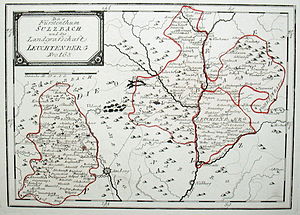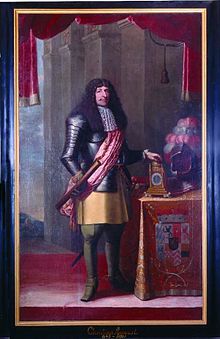Pfalz-Sulzbach
|
Territory in the Holy Roman Empire |
|
|---|---|
| Pfalz-Sulzbach | |
| coat of arms | |

|
|
| map | |

|
|
| Principality of Sulzbach, map section ~ 60x90 km | |
| Alternative names | Duchy of Palatinate-Sulzbach |
| Arose from | Pfalz-Neuburg |
| Form of rule | county |
| Ruler / government | Count |
| Today's region / s |
DE-BY
|
| Reichskreis | Bavarian |
| Capitals / residences | Sulzbach |
| Dynasties | 11th and 12th centuries Counts of Sulzbach ; 1305-1808 Wittelsbach |
| Denomination / Religions | Roman Catholic , now Lutheran |
| Language / n |
German
|
| Incorporated into |
Kingdom of Bavaria
|
The County Palatine of Pfalz-Sulzbach , also known as Duchy of Pfalz-Sulzbach , was an independent, imperial immediacy principality of the Holy Roman Empire of the German nation , which by the Neuburger main comparison of 1656 from the Wittelsbach Duchy of Neuburg had emerged. However, it never had a seat in the Princely College of the Reichstag , as it was formally only a branch of the Wittelsbach family , which was never officially enfeoffed with it.
The duchy comprised the residential town of Sulzbach with the associated regional court as well as the rule of Breitenstein , the Pleystein office (since 1764), the neo-castle half of the Parkstein - Weiden community office (since 1714) and the Floß care office with the Vohenstrauss court . The total area was about 1500 km².
history
The family of the Counts of Sulzbach , who were influential and powerful in the 11th and 12th centuries, died out in 1188, with the result that most of their property fell to the Wittelsbach family. Sulzbach became part of the Junge Pfalz from 1505 . After Count Palatine Ottheinrich I. von Neuburg inherited the Electoral Palatinate , he ceded the Neuburg and Sulzbach area in the Heidelberg Succession Treaty of 1557 to Wolfgang von Pfalz-Zweibrücken . Wolfgang initially gave Sulzbach as a Paragium to his son, Count Palatine Ottheinrich II , who resided in the local castle from 1582 . After he died in 1604 without an heir, Sulzbach fell back to Wolfgang's eldest son, the founder of the newer Neuburg line, Philipp Ludwig . With his death in 1614 Sulzbach was again separated as Paragium, this time for Philipp Ludwig's younger son, Count Palatine August , but remained under the suzerainty of the main line. His son Christian August obtained the sovereignty of Palatinate-Sulzbach as Duke in the Neuburg Main Settlement of 1656. In 1742 the main line of the Neuburg Count Palatine died out, as a result of which the Sulzbach branch with Karl Theodor took over there. In 1777 the Bavarian Wittelsbach family was also inherited, so that under Karl Theodor the large Wittelsbach states Palatinate and Bavaria were reunited for the first time in centuries. After the Sulzbach line died out in 1799, its territories fell to Pfalz-Birkenfeld-Bischweiler-Zweibrücken .
The Duchy of Pfalz-Neuburg / Sulzbach was abolished in 1808 and became part of the new Kingdom of Bavaria . When Bavaria was divided up in 1837, Neuburg was merged with Swabia to form an administrative district (district).
Count Palatine and Dukes of Palatinate-Sulzbach

- 1569–1604 Otto Heinrich
- 1604–1614 Philipp Ludwig
- 1614–1632 August
- 1632–1708 Christian August (independent from Pfalz-Neuburg since 1656)
- 1708–1732 Theodor Eustach
- 1732–1733 Johann Christian Joseph
- 1733–1799 Karl Theodor , Elector Palatinate (as Karl IV.) And of Bavaria (as Karl II.)
- 1799–1808 Maximilian Joseph , Elector of Bavaria and the Palatinate (as Maximilian IV.)
More family members
- Amalia Maria Therese von Pfalz-Sulzbach (1651–1721), princess from the House of Wittelsbach and Carmelite
- Elisabeth Auguste von Pfalz-Sulzbach (1721–1794), by marriage Electress of the Palatinate and Bavaria
- Ernestine Theodora von Pfalz-Sulzbach (1697–1775), prioress of the Carmelite monastery in Neuburg
- Franziska Christine von Pfalz-Sulzbach (1696–1776), abbess of the Essen monastery
- Hedwig von Pfalz-Sulzbach (1650–1681), Archduchess of Austria; Duchess of Saxony-Lauenburg
- Johann Ludwig von Pfalz-Sulzbach (1625–1649), Swedish general in the Thirty Years' War
- Joseph Karl von Pfalz-Sulzbach (1694–1729), Hereditary Prince of Pfalz-Sulzbach
- Maria Anna Amalia Auguste von Pfalz-Sulzbach (1693–1762), princess from the House of Wittelsbach, Carmelite and prioress
- Philipp Florinus von Pfalz-Sulzbach (1630–1703), Count Palatine of the Palatinate and Imperial Field Marshal General
